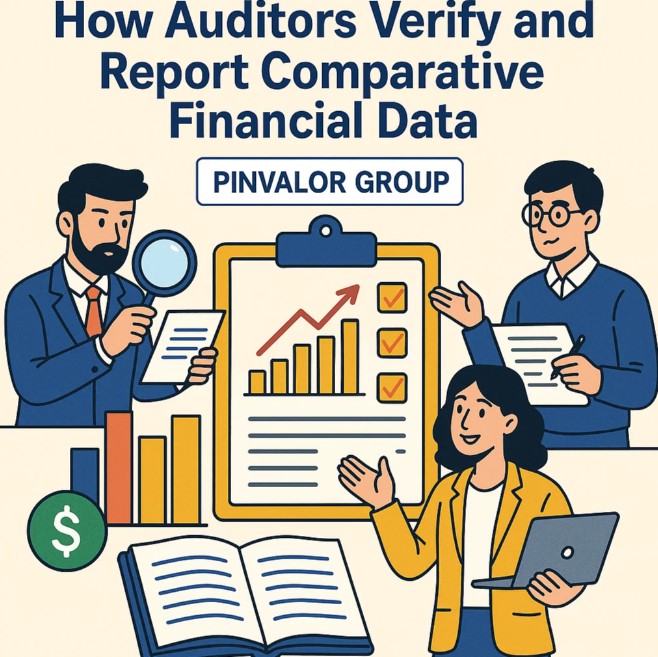
SA 710 Insights: How Auditors Verify and Report Comparative Financial Data
In the realm of financial auditing, the clarity and consistency of financial information across periods are essential for users to make informed decisions. Comparative financial data allows stakeholders to track performance trends, assess financial health over time, and identify any significant changes. To ensure that this comparative information is reliable and accurately presented, auditors adhere to SA 710 – Comparative and Corresponding Figures.
This blog explores the key insights into how auditors verify and report comparative financial data under SA 710, highlighting the standard’s requirements, common challenges, and best practices.
Why is SA 710 critical for maintaining transparency in comparative financial reporting?
Auditing comparative figures is more than checking numbers—it’s about ensuring transparency and consistency across periods. SA 710 guides auditors to uphold these essential principles
What is SA 710 and Why Does It Matter?
SA 710 is a Standard on Auditing issued by the Institute of Chartered Accountants of India (ICAI), which provides guidance to auditors on their responsibilities when financial statements include comparative figures from prior periods.
When companies present financial statements with prior period data alongside the current year’s figures, it is crucial that these comparative figures are audited or reviewed appropriately. This ensures that users receive trustworthy information that accurately reflects the company’s historical performance.
Auditor’s Responsibilities Under SA 710
SA 710 sets out the auditor’s key responsibilities in relation to comparative financial data, including:
1. Verification of Corresponding Figures
Auditors must verify that the comparative figures included in the current financial statements correspond to the figures that were reported in the prior period’s audited financial statements. This means ensuring consistency and accuracy in the comparative data presented.
- If the prior period’s figures were audited by the same auditor, they should refer to their prior audit report.
- If the prior period’s figures were audited by a different auditor or not audited at all, the current auditor must take appropriate steps to obtain sufficient audit evidence regarding those figures.
2. Handling Adjustments and Restatements
If the prior period figures have been restated due to corrections of errors, changes in accounting policies, or reclassifications, the auditor must:
- Verify that these adjustments have been properly accounted for.
- Ensure that clear disclosures about the nature and reason for these changes are included in the financial statements.
- Consider the impact of such changes on the audit opinion.
3. Reporting in the Auditor’s Report
The auditor’s report should clearly communicate the auditor’s responsibilities related to comparative figures, including:
- Whether the comparative figures have been audited or reviewed.
- Any modifications or emphasis of matter relating to comparative information.
- If there is any inconsistency or inability to verify prior period figures, the auditor must disclose this in the report.

How Auditors Verify Comparative Financial Data
The verification process involves several important steps:
Reviewing Prior Audit Documentation
When the auditor has audited the prior period, they should review the prior audit working papers to understand the basis for the prior figures and any issues noted previously.
Obtaining Evidence for Prior Period Figures
If the prior period figures were audited by another auditor or not audited at all, the current auditor may:
- Perform audit procedures on the prior period figures to the extent necessary.
- Request a copy of the prior auditor’s report and working papers.
- Consider whether reliance can be placed on prior auditor’s work, or if additional audit work is required.
Examining Adjustments and Disclosures
Auditors evaluate the appropriateness of any adjustments made to prior period figures and the adequacy of disclosures explaining these changes.
Ensuring Consistency of Presentation
The auditor verifies that comparative figures are presented in a manner consistent with the current period’s financial statements to allow meaningful comparison.
Common Challenges in Auditing Comparative Figures
- Lack of Access to Prior Audit Evidence: In some cases, the auditor may not have access to sufficient evidence for prior period figures, especially if audited by a different firm or if records are incomplete.
- Restatements and Changes in Accounting Policies: Adjusting comparative figures for errors or changes in policies can complicate the audit, requiring thorough examination and clear communication.
- Presentation and Format Differences: Differences in presentation formats between periods can make comparison difficult and require auditors to evaluate if such differences are adequately explained.
Best Practices for Auditors
To effectively comply with SA 710, auditors should:
- Maintain clear documentation on how comparative figures were verified.
- Communicate early with management about the need for disclosures on prior period adjustments.
- Obtain written representations from management regarding the completeness and accuracy of comparative information.
- Emphasize transparency in the auditor’s report regarding the status and verification of comparative figures.
- Coordinate with prior auditors, if applicable, to obtain necessary information.
Conclusion
SA 710 ensures that the presentation of comparative financial data meets the highest standards of accuracy and transparency. Auditors play a critical role in verifying that comparative and corresponding figures are consistent, appropriately adjusted, and clearly reported. By adhering to SA 710, auditors help enhance the reliability of financial statements, enabling stakeholders to make sound economic decisions based on consistent and trustworthy data.
